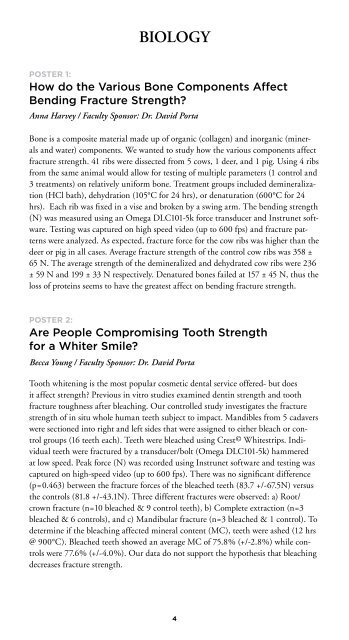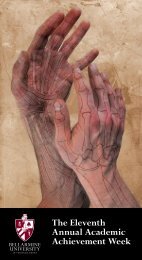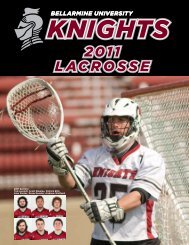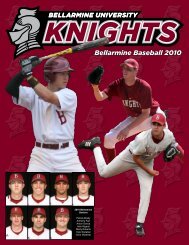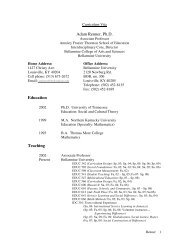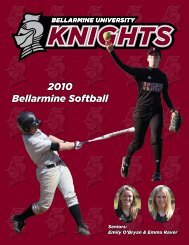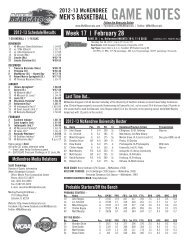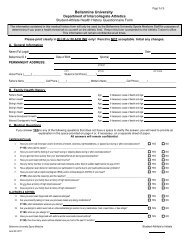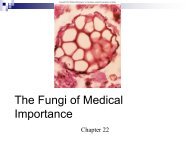College of Arts and Sciences - Bellarmine University
College of Arts and Sciences - Bellarmine University
College of Arts and Sciences - Bellarmine University
- No tags were found...
Create successful ePaper yourself
Turn your PDF publications into a flip-book with our unique Google optimized e-Paper software.
BIOLOGYPoster 1:How do the Various Bone Components AffectBending Fracture Strength?Anna Harvey / Faculty Sponsor: Dr. David PortaBone is a composite material made up <strong>of</strong> organic (collagen) <strong>and</strong> inorganic (minerals<strong>and</strong> water) components. We wanted to study how the various components affectfracture strength. 41 ribs were dissected from 5 cows, 1 deer, <strong>and</strong> 1 pig. Using 4 ribsfrom the same animal would allow for testing <strong>of</strong> multiple parameters (1 control <strong>and</strong>3 treatments) on relatively uniform bone. Treatment groups included demineralization(HCl bath), dehydration (105°C for 24 hrs), or denaturation (600°C for 24hrs). Each rib was fixed in a vise <strong>and</strong> broken by a swing arm. The bending strength(N) was measured using an Omega DLC101-5k force transducer <strong>and</strong> Instrunet s<strong>of</strong>tware.Testing was captured on high speed video (up to 600 fps) <strong>and</strong> fracture patternswere analyzed. As expected, fracture force for the cow ribs was higher than thedeer or pig in all cases. Average fracture strength <strong>of</strong> the control cow ribs was 358 ±65 N. The average strength <strong>of</strong> the demineralized <strong>and</strong> dehydrated cow ribs were 236± 59 N <strong>and</strong> 199 ± 33 N respectively. Denatured bones failed at 157 ± 45 N, thus theloss <strong>of</strong> proteins seems to have the greatest affect on bending fracture strength.Poster 2:Are People Compromising Tooth Strengthfor a Whiter Smile?Becca Young / Faculty Sponsor: Dr. David PortaTooth whitening is the most popular cosmetic dental service <strong>of</strong>fered- but doesit affect strength? Previous in vitro studies examined dentin strength <strong>and</strong> toothfracture toughness after bleaching. Our controlled study investigates the fracturestrength <strong>of</strong> in situ whole human teeth subject to impact. M<strong>and</strong>ibles from 5 cadaverswere sectioned into right <strong>and</strong> left sides that were assigned to either bleach or controlgroups (16 teeth each). Teeth were bleached using Crest© Whitestrips. Individualteeth were fractured by a transducer/bolt (Omega DLC101-5k) hammeredat low speed. Peak force (N) was recorded using Instrunet s<strong>of</strong>tware <strong>and</strong> testing wascaptured on high-speed video (up to 600 fps). There was no significant difference(p=0.463) between the fracture forces <strong>of</strong> the bleached teeth (83.7 +/-67.5N) versusthe controls (81.8 +/-43.1N). Three different fractures were observed: a) Root/crown fracture (n=10 bleached & 9 control teeth), b) Complete extraction (n=3bleached & 6 controls), <strong>and</strong> c) M<strong>and</strong>ibular fracture (n=3 bleached & 1 control). Todetermine if the bleaching affected mineral content (MC), teeth were ashed (12 hrs@ 900°C). Bleached teeth showed an average MC <strong>of</strong> 75.8% (+/-2.8%) while controlswere 77.6% (+/-4.0%). Our data do not support the hypothesis that bleachingdecreases fracture strength.4


